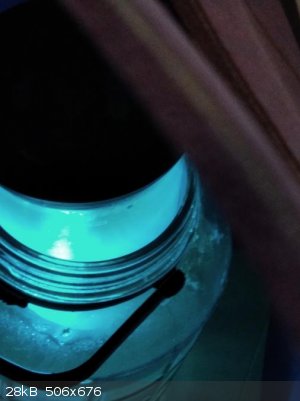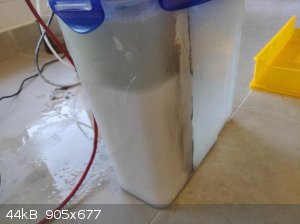| Pages:
1
2 |
mysteriusbhoice
Hazard to Others
  
Posts: 477
Registered: 27-1-2016
Member Is Offline
Mood: Became chemistry catboy Vtuber Nyaa
|
|
Quote: Originally posted by macckone  | You would probably be better served with a siphon type arrangement.
You can modify an aquarium pump to act as a vacuum.
The intermediate vessel can then be emptied without impacting the cell. |
The impeller of aquarium pumps seem to be housed in such a way that its only the plastic which is exposed which makes sense given its meant to be
underwater for years.
Now for the siphon idea so I hook up a drain hose to the pump but then how would I fill the cell ?
would I have to use 2 pumps or just 1 hose leading to a reservoir but what worries me is the pressure of the gas exerted onto the liquid if I were to
only use one pump so im guessing 2 is the magic number with regulator valves on both ends to control the flow rate for both pumps.
I found one of those super mini 5v USB mini water pumps which fit in your hand and overall that should handle continuous mode operation of the cell.
Honestly tho id rather just have a single pump tbh since I will actually have 2 cathode chambers which will be made very large in the final cell.
and only intermittent filling and draining would be required
[Edited on 21-9-2020 by mysteriusbhoice]
[Edited on 21-9-2020 by mysteriusbhoice]
|
|
|
macckone
Dispenser of practical lab wisdom
    
Posts: 2168
Registered: 1-3-2013
Location: Over a mile high
Member Is Offline
Mood: Electrical
|
|
A lot of how you do it is going to depend on the cell design.
In a commercial operation there is continuous flow through the electrolytic portion of the operation.
|
|
|
mysteriusbhoice
Hazard to Others
  
Posts: 477
Registered: 27-1-2016
Member Is Offline
Mood: Became chemistry catboy Vtuber Nyaa
|
|
New HCl reactor chamber made of acrylic to resist UVC better.
safety pop off cap installed and volume reduced

[Edited on 25-9-2020 by mysteriusbhoice]
|
|
|
mysteriusbhoice
Hazard to Others
  
Posts: 477
Registered: 27-1-2016
Member Is Offline
Mood: Became chemistry catboy Vtuber Nyaa
|
|
Porous barrier itself has poor efficiency because of the migration of hypochlorite produced by the equilibrium reaction to the cathode side and
migration of hydroxides to the anode side...
Instead I have changed it so that the anode side of the PVC porous barrier is now painted with PVA-Borate hence the birth of a new membrane I call the
PVC substrate PVA-Borate membrane.
Ion conductivity increased compared to porous barrier alone after addition, I just hope due to the lesser forces of osmosis the membrane will be
stable in the anode chamber even with increase in hydroxide conc.
|
|
|
mysteriusbhoice
Hazard to Others
  
Posts: 477
Registered: 27-1-2016
Member Is Offline
Mood: Became chemistry catboy Vtuber Nyaa
|
|
the HCl generator is finalized using the new 4 liter MMO salt cake PVA ion exchange membrane cell and the new glass UVC chamber since plastics seem to
fk off due to the UV.
video below
https://youtu.be/TQdvB5W4Zb8
 
|
|
|
Fantasma4500
International Hazard
    
Posts: 1681
Registered: 12-12-2012
Location: Dysrope (aka europe)
Member Is Offline
Mood: dangerously practical
|
|
does it fume once cooled down too? very interesting.
|
|
|
manomanom
Harmless

Posts: 7
Registered: 17-11-2013
Member Is Offline
Mood: No Mood
|
|
very nice work! i hope you dont mind me posting this here...
it reminds me of experiment i tried;(after reading HCl wiki)
"salt-water turns into Cl at one electrode and H at the other"
...
so i connected two water bottles with a cotton membrane/bridge,
and poured in some salt water, ice cream rock salt, (just NaCl)
graphite electrodes threw the lid of each bottle, lid not airtight
(graphite was from burned pencils, because carbon is un-reactive)
this was placed in a sealed container, with water at the bottom..
(i read somewhere Cl gas would absorb into water, forming HCl)
then ran DC current (probably 9V) and let it run outside all night.
i had no way of checking my experiment except ph-strip-paper..
one bottle was very acidic, and the other bottle was very basic,
(if i remember correctly, NaOH is the byproduct on basic side)
water at bottom of sealed container was only slightly acidic.
Another interesting method i read about;
if PVC pipe is burned it releases Cl gas,
when this is distilled into bucket of water,
(as in the production of oil from plastics)
the water is turned into HCl... allegedly.
*i just wish this was a little bit easier to understand your procedure,
the technical terms are like a secret language, and go over my head.
[Edited on 9-5-2021 by manomanom]
|
|
|
rockyit98
Hazard to Others
  
Posts: 283
Registered: 12-4-2019
Location: The Known Universe
Member Is Offline
Mood: no mood is a good mood
|
|
try polyvinyl alcohol (PVOH) instead of polyvinyl acetate (PVA) because PVA disintegrate in basic media .if you can't buy PVOH for some reason heat
pva with NaOH solution to get PVA solution .
"A mind is a terrible thing to lose"-Meisner
|
|
|
mysteriusbhoice
Hazard to Others
  
Posts: 477
Registered: 27-1-2016
Member Is Offline
Mood: Became chemistry catboy Vtuber Nyaa
|
|
Quote: Originally posted by rockyit98  | | try polyvinyl alcohol (PVOH) instead of polyvinyl acetate (PVA) because PVA disintegrate in basic media .if you can't buy PVOH for some reason heat
pva with NaOH solution to get PVA solution . |
I dechlorinate PVC to get PV(OH) which I can form citrate esters with which has free carboxylic acid groups for ion exchange!
These can survive 35% H2SO4 in operation for 100s of runs of my H2SO4 cell and also high levels of chlorine since carboxylic acid membranes are used
commercially.
They use perfluorinated membranes with carboxylic acids commercially and another layer of sulfonated polystyrene.
|
|
|
symboom
International Hazard
    
Posts: 1143
Registered: 11-11-2010
Location: Wrongplanet
Member Is Offline
Mood: Doing science while it is still legal since 2010
|
|
Nice you have contributed greatly to amature chemistry
Especially with your processes to make hydrochloric acid along with designing membranes and a more compact process of making nitric acid. Did not
think these were even possible to do in a home setting. Very inspiring.
The only thing left to see is reducing agents like lithium aluminum hydride. We got Alkali metals and Phosphorus production which is incredible. Then
we could just about make any chemical from scratch.
[Edited on 11-5-2021 by symboom]
|
|
|
helzblack
Harmless

Posts: 35
Registered: 6-8-2019
Member Is Offline
|
|
Can you use your membranes for the electrolysis of magnesium sulfate into hydrochloric acid?
|
|
|
helzblack
Harmless

Posts: 35
Registered: 6-8-2019
Member Is Offline
|
|
I see you have a video on youtube using calcium sulfate. If you tritate the acid with sodium hydroxide what concentratuoin do you get?
|
|
|
helzblack
Harmless

Posts: 35
Registered: 6-8-2019
Member Is Offline
|
|
Also you can always use density tables.
|
|
|
helzblack
Harmless

Posts: 35
Registered: 6-8-2019
Member Is Offline
|
|
Quote: Originally posted by symboom  | Nice you have contributed greatly to amature chemistry
Especially with your processes to make hydrochloric acid along with designing membranes and a more compact process of making nitric acid. Did not
think these were even possible to do in a home setting. Very inspiring.
The only thing left to see is reducing agents like lithium aluminum hydride. We got Alkali metals and Phosphorus production which is incredible. Then
we could just about make any chemical from scratch.
[Edited on 11-5-2021 by symboom] |
Where do we have phosphorus?
In any case using a DIY tube furnace you could use the mehod described in Small-Scale lab reagent synthesis to make lithium aluminum hydride.
|
|
|
Hexabromobenzene
Hazard to Others
  
Posts: 128
Registered: 27-4-2021
Member Is Offline
|
|
Can i use diaphragm from spent reverse osmos membrane from water filter for this cell?
|
|
|
mysteriusbhoice
Hazard to Others
  
Posts: 477
Registered: 27-1-2016
Member Is Offline
Mood: Became chemistry catboy Vtuber Nyaa
|
|
nope those only allow water molecules through.
|
|
|
Fluorite
Hazard to Others
  
Posts: 139
Registered: 26-12-2018
Location: United Arab Emirates
Member Is Offline
|
|
Would exposing a TCCA suspension in water to UVC turn it into HCl, Oxygen and cyanuric acid?
|
|
|
Precipitates
Hazard to Others
  
Posts: 136
Registered: 4-12-2023
Location: SE Asia
Member Is Offline
Mood: Acid hungry
|
|
To some extent, yes:
TCCA + H2O -> CA + HOCl
HOCl <-> H+ + OCl-
HOCl/OCl- + hv -> HO•/O•- + Cl•
O•- + H2O <-> HO• + OH-
OH• + HOCl/OCl- -> ClO• + H2O/HO-
Cl• + HOCl/OC- -> ClO• + HCl/Cl-
Cl• + Cl- <-> Cl2-•
Adapted from "Synergy between UV light and trichloroisocyanuric acid on methylisothiazolinone degradation: Performance, kinetics and degradation pathway."
|
|
|
Sulaiman
International Hazard
    
Posts: 3721
Registered: 8-2-2015
Location: 3rd rock from the sun
Member Is Offline
|
|
Since only a modest flow rate is required,
a peristaltic pump may be more suitable as only tubing is exposed to the chemicals.
CAUTION : Hobby Chemist, not Professional or even Amateur
|
|
|
Hexabromobenzene
Hazard to Others
  
Posts: 128
Registered: 27-4-2021
Member Is Offline
|
|
For this synthesis, you can use the diaphragm described in this post
https://www.sciencemadness.org/whisper/viewthread.php?tid=16...
|
|
|
| Pages:
1
2 |